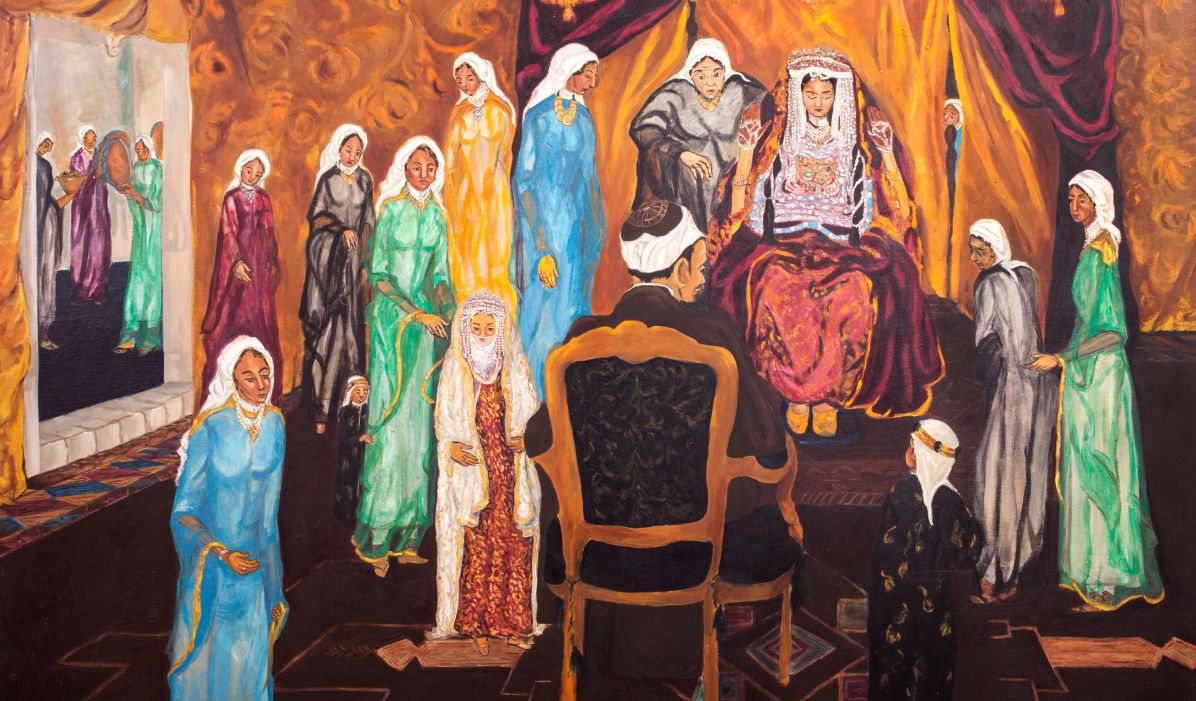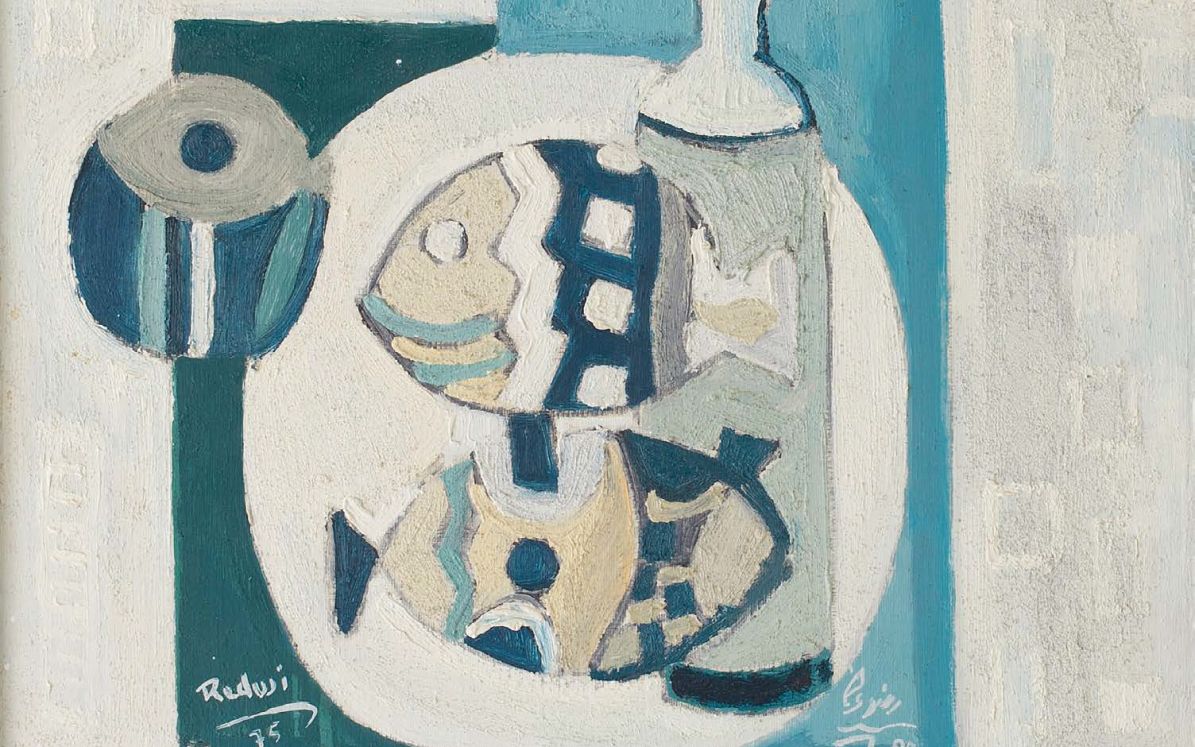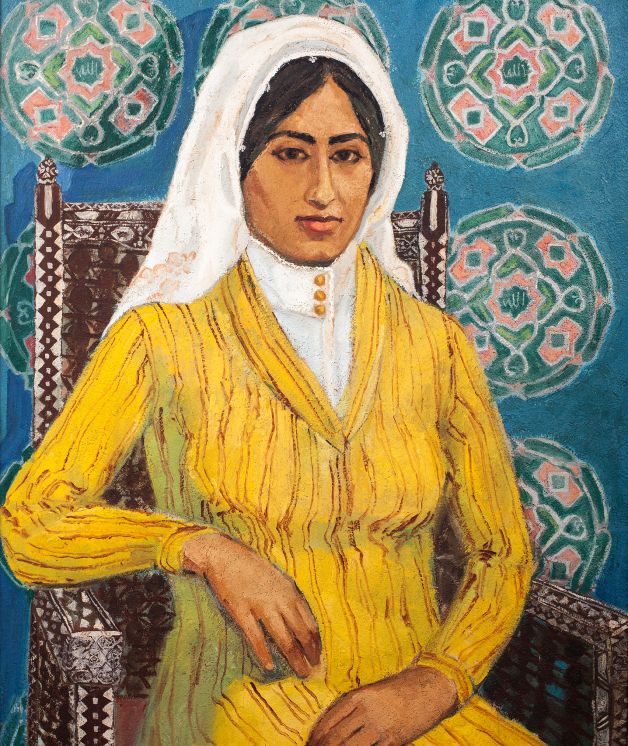The art of life, and life of art
Al-Nassah (1975) In this most important ceremony, the bride appears before the groom for the first time. Attired in a silk dress embellished with a jewelry encrusted cushion on her chest, the bride mounts a platform opposite to the bride-groom, who reads from the Holy Quran. When this ritual is completed, the groom stands up, empties his pockets of small coins which the children run to pick up for themselves. Then he uncovers his bride’s veil, places gold coins on her forehead, which afterwards are given to the lady who dressed her for the ceremony. The silver embroidered wedding dress is rented by most families and most of the jewelry worn by the bride is borrowed from family and friends. A special throne is also made or rented for the occasion. Preparations were elaborate in order to make the bride's appearance as splendid as possible.

‘Theme-special’ featured Saudi artist, Safeya Binzagr, the “mother of art.”
With over 35 exhibitions, over 450 artworks, Ms. Binzagr, known as “mother of art,” has spent a lifetime creating and capturing the multifaceted beauty of past Saudi life— the essence of its people, its colorful traditions, deep heritage and long history.“Art is my life,” she told Ithraeyat Magazine in an exclusive interview. For the past five decades, Safeya Binzagr’s art creations have been and remain one of the Kingdom’s most
memorable cultural ambassadors, telling the story of a nation and its human spirit. She is the artist behind the famous ‘Mona Lisa of Hijaz,’ also known as ‘The Hijazi Mona Lisa,’ originally titled 'Al Zaboon.’ It had its big debut at the 1980 Gallerie Duron art exhibition in Paris. Painted in oil colors back in 1969, it presents Hijazi women’s traditional clothing in the western region of Saudi Arabia. Some believe it to be a self-portrait of the artist.

Al-Nassah (1975) In this most important ceremony, the bride appears before the groom for the first time. Attired in a silk dress embellished with a jewelry encrusted cushion on her chest, the bride mounts a platform opposite to the bride-groom, who reads from the Holy Quran. When this ritual is completed, the groom stands up, empties his pockets of small coins which the children run to pick up for themselves. Then he uncovers his bride’s veil, places gold coins on her forehead, which afterwards are given to the lady who dressed her for the ceremony. The silver embroidered wedding dress is rented by most families and most of the jewelry worn by the bride is borrowed from family and friends. A special throne is also made or rented for the occasion. Preparations were elaborate in order to make the bride's appearance as splendid as possible.
“Al Zaboon wasn’t meant to be a self-portrait exactly,” Ms. Binzagr said. “It was drawn to show the pride of a Hijazi woman. They wear the traditional “zaboon” dress from that part of the country, and it is always cut in the same style while made from different material. The bodice underneath was fastened by six buttons of silver, gold or diamonds, depending on the woman’s wealth, all connected by a chain. Her hair would be worn in the “mihramah wa mudawwarah” style in which it was braided with a cotton scarf coiled around the head, then covered up with a cap. The scarf placed on top was of very fine cotton voile and often printed in a pale yellow and violet motif.”
This is just one of hundreds of her famous pieces, each meticulously documenting important historic elements of Saudi culture. From traditional dress to architecture to daily life, such as children playing the marbles-like game of Al Kubush, which makes use of bones from the joints of goats or camels; the Mahmal (ceremonial palanquin) being carried through Jeddah before the Hajj; and merchants selling in souqs and various fishing and hunting traditions. One of her most dynamic works included capturing traditional Saudi weddings, when ‘white was red’ and Saudi brides wore traditional colorful bridal dresses instead of today's white and performed a set of rituals for luck and prosperity.
Her unique style of simple structures, powerful formations and imposing shapes evolved from experimenting with different renaissance and impressionist styles inspired from great artists such as Gitto, Fra Angelico, and Cézanne, along with an oriental touch using Japanese and Chinese brush strokes.
Born and raised in Harat Al-Sham in the heart of Jeddah in 1940, that traditional setting left a lasting impression on the artist. Ms. Binzagr then lived in Egypt and the UK, studying art as a postgraduate at Saint Martins College. She held the first modern art exhibition in Jeddah in 1968 with her friend and another pioneer Saudi artist, the late Mounirah Mosly who died in 2019.
At that time, there were no galleries, and therefore the innovative Ms.Binzagr held it at the Dar Al-Tarbia Al-Hadetha, a school for girls, and it was a big hit, laying the foundation for many future art exhibitions.
“I salute [Safeya Binzagr’s] sense of responsibility as a fellow citizen and artist who has contributed through public and private institutions to support the cultural and artistic movement in our country. One can only admire her ceaseless ambition to revive our heritage and preserve it, and to make her art serve the cause of such heritage.”
”Don’t stop, don't let obstacles be an excuse to give up,” she said, an important piece of advice for all artists and creatives. “Hard work always pays off and pushes you to be in the beginning of the line.”
And this passion for art soon paved the way for Saudi art to travel and be exhibited abroad, with Ms.Binzagr’s first international exhibition held in 1973 at the Woodstock Gallery in London. Then in the 1980s, her art toured London, Paris and Geneva, presenting Saudi Arabian culture to the world and breaking down barriers and stereotypes about Saudi artists, and in particular Saudi women.
“One of the misconceptions was that they don’t think that Saudi women can accomplish something special,” said Ms. Binzagr. “But in fact, there are a lot of Saudi women who succeed in many different fields from a long time ago. They think the women here are tied down and can’t make a big leap if she is willing to, which is not true, since a long time ago Saudi women were working hard in many fields and today, the world can see it all, and women can harvest the results of their relentless work through the last century.”
In 2017, she was awarded First Class honors in the Order of King Abdulaziz, reflecting her contributions to Saudi culture. But before that, one of her “greatest dreams” came true when she officially opened Darat Safeya Binzagr, in January 2000, the first of its kind in Jeddah.
The building of the Darat was ready by 1995, and is distinguished by its innovative architectural design; its exterior echoes the great facades of Nabataean Mada'in Saleh. The external walls are simple enough to maintain harmony with the minute details of the windows and the doors, which are made of engraved wood. The intricate woodwork follows the conventional intricate patterns that used to ornament the doors of the old houses in Jeddah, and replicates the engravings on the door of the Ms. Binzagr old family home.

AL-Kindasa (1986) This was the first water purification method introduced during Ottoman rule. It was first operated with coal acting as its power supply until the outbreak of local war. Due to the coal shortage experienced during the internal conflict, timber acted as a substitute for coal, but ultimately caused much damage by 1346H. As various attempts at repair failed, two large machines were subsequently introduced by the Saudi Government. Al-Kindasa however, continued to supply the City of Jeddah along with the Al-Waziriya Spring until Moharram 1367H. This marked the date of operation of the Al-Aziziya Spring brought into being by order of King Abdul Aziz Al Saud.
With a special library of 7,000 books, including many rare editions, Darat also runs painting competitions for children and lectures for adults, and visitors to the museum will not only see beautiful art, they will be stepping back in time. Ms. Binzagr travelled across Saudi Arabia to learn about costumes, asking families for donations, and going to archives and libraries abroad to look at photographs.
The outfits, which would have been worn on special occasions such as birthdays or national days, are complete: they include headdress, shoes, jewelry, all depicted in her watercolors or assembled on mannequins. Ms. Binzagr doesn’t sell her pieces, as each one is too personally precious, and is too dearly connected to her memories, and therefore visitors to the museum can see her full collection.
”I'm painting every day still, and working now on a series of paintings. But I will reveal the full information later when I finish it,” she said.
And when asked about some information some may not know about her, she mentioned her love of nature and her pets. “I like cats and birds, and I have two parrots,” she said, whose names are Honey and Spicy.
Embodying the very essence of what a true artist is, the passion, the vision, and the unstoppable drive, Ms. Binzagr never starts a piece unless she finishes it.
“Sometimes a piece may take longer, but eventually I finish it,” she said.
And there lies yet another lesson from the iconic artist that the rest of us— in whatever creative field we work in— should carry forward in our lives if we are to leave a mark in the ever-vibrant fabric of life and art.


